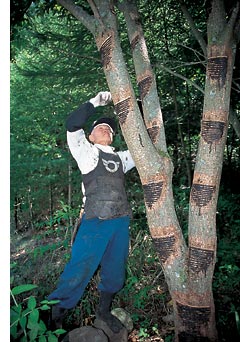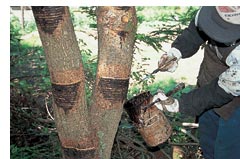|
Collecting sap from lacquer trees
Lacquerware is one of Japan's best-known traditional crafts. Applying lacquer to wooden utensils gives them a unique luster and makes them more durable. The lacquer tree is a broadleaf, and grows where conditions are right, in a broad area from Indochina through China to Japan. Lacquer comes from the tree sap. Lacquerware crafts were developed a long time ago in Japan, and were well advanced in the 17th century, when the English word "japan" was first used to signify lacquerware, just as the word "china" came to mean ceramics. The words "japan" and "japanned" are still used today in many parts of the world when referring to lacquerware.
Collecting sap from lacquer trees is a job for artisans. They have practiced the technique for more than 1,200 years in one major production center, Joboji-machi in Iwate Prefecture. The lacquer there is known for its exceptional purity, and was used during restoration work at the Temple of the Golden Pavilion in Kyoto, from 1985 to 1987.
One sap producer, Iwadate Shoji, has developed his skills to a high level over more than 60 years. He says only experience and intuition can tell someone which trees will produce a lot of sap, and where the bark should be cut to get the maximum amount.
He collects sap every year between June and October. It flows the most late at night, so he begins work well before dawn. The sap oozes out from lines cut in the bark. He lets the tree rest for about four days before cutting more lines, to keep the tree healthy. During the half-year season, one lacquer tree will give about one cup of sap. As with all Japanese traditional crafts, much patience and experience are required.
|


|
Top: Iwadate Shoji collecting sap from a lacquer tree. The work is done before the sun rises, from June to October every year.
Above: One lacquer tree yields only about one cup of raw lacquer during the half-year collection period.
|
|